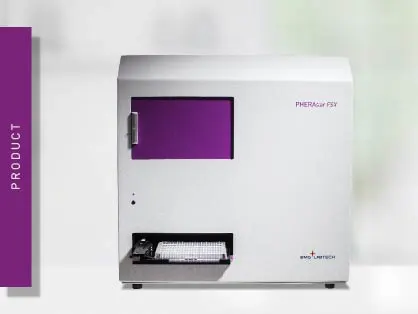
PHERAstar FSX
Powerful and most sensitive HTS plate reader


Discover how Rauf Latif utilizes BMG LABTECH's CLARIOstar microplate reader to develop novel small-molecule agonists and antagonists targeting the thyroid stimulating hormone receptor.

Rauf Latif (Associate Professor of Medicine, Endocrinology, Diabetes and Bone Disease at the Icahn School of Medicine, Mount Sinai, New York)
The microplate reader is an indispensable piece of equipment. At almost every clinical diagnostic or research lab, microplates will be filled with samples and taken to diagnostic and analytical instruments for study, to begin the process again. Rauf Latif uses the CLARIOstar microplate reader from BMG LABTECH for his research into developing novel small-molecule agonists and antagonists to the thyroid stimulating hormone receptor, one of the body’s many G-protein coupled receptors.
What is a G-protein coupled receptor (GPCR) and why are they important in research?
G-protein coupled receptors (GPCRs) is a large family of cell surface receptors found in several tissues. They act like an inbox for messages coming from the extracellular environment and activate internal signal transduction pathways and ultimately, cellular responses.
GPCRs are the most intensively studied drug targets due to their substantial involvement in human pathophysiology and their pharmacological tractability. Approximately 34% of all drugs approved by the US Food and Drug Administration are targeted to GPCRs.
Why is there a focus on developing GPCR assays?
GPCRs are highly druggable targets, 30 to 50% of all medications on the market exert their effect via no more than 80 members of this receptor family. To develop novel therapeutics to existing receptors, we have to first focus on developing robust GPCR assays. GPCR assays, whether they are cell-based or non-cell based, are a boon to developing and testing the various small molecule- or peptide-based drugs.
Your research is focused on the thyroid stimulating hormone receptor (TSHR), which is expressed on the surface of thyroid epithelial cells. What is its role in the body?
The thyroid gland produces thyroid hormones T3 and T4 which all cells in the body need for metabolism. The TSHR, which is a classic GPCR, controls the growth and development of the thyroid gland. It orchestrates the function of the gland with other molecules and receptors to maintain physiological levels of T3 and T4. Under normal physiological conditions the TSHR is activated by thyroid stimulating hormone (TSH), which is produced from the anterior pituitary.
Like any other organ, the thyroid is subject to attack either by the body’s own immune system or by damage due to various genetic and non-genetic factors. In patients suffering from Graves’ disease or hyperthyroidism, the immune cells produce a type of antibody that hyper-stimulates the receptor, thereby producing high levels of thyroid hormone.
What impact has having a microplate reader had on your research with the TSHR?
The versatility of the newer plate readers, like the CLARIOstar microplate reader that we have in our laboratory, has given us the opportunity to study the kinetics of the TSHR response to various small molecules. It has allowed us to develop fluorescent-based assays such as FRET (Fluorescence Resonance Energy Transfer) to study receptor-receptor interactions, and fluorescent ELISA (enzyme-linked immunosorbent assay) for measurement of antibodies in serum.
What have you been able to achieve with the CLARIOstar with LVF Monochromator technology?
We have developed and optimized cell-based transcriptional assays to detect the response resulting from the activation of G proteins by the TSHR. By tagging cells transfected with a specific response element to the luciferase gene, we now have an array of cell-based assays that measure signals emanating as the result of activation with different G protein classes. Using this cell-based assay we have identified a small molecule that shows G protein bias at the TSHR. Furthermore, the plate reader has been helpful in developing other cell-based and ELISA assays for screening antibodies against the TSHR that arise as result of immunization in mouse models of the disease.
What advice would you give to someone who is looking for a new microplate reader?
I would suggest look for a microplate reader that a) has different types of measurements it can perform; b) is versatile; c) has easy-to-use software d) is rapid and sensitive; e) gives you the option of using different microplate configurations and f) offers a price and technical support on the instrument from company that we can depend on.
Why it is important to choose a microplate reader that is able to deliver reproducible results?
It is very important to have a reliable plate reader because good, reproducible results are key to any assay. A lot of time and money is invested in developing an assay and it would be sad to see that clear conclusions cannot be reached because the microplate reader is not reliable. In that respect, the CLARIOstar is robust and reliable with no or very little fluctuations between measurements. It is a workhorse that we trust in microplate assay readings.
The interview was firstly published on nature.com
Powerful and most sensitive HTS plate reader